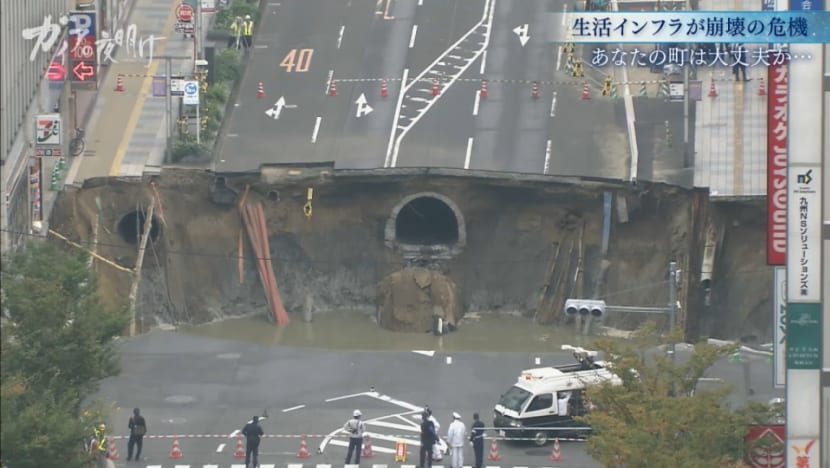Gaia Series 102: Tackling the Infrastructure Crisis!
This week’s episode uncovers Japan’s crumbling infrastructure, from sewer collapses to bridge failures, and the innovators racing to protect lives.


This audio is generated by an AI tool.
From deadly sinkholes to transparent bridge repairs, Japan tackles its hidden infrastructure crisis with ingenuity.
Japan’s infrastructure, once the pride of its post-war rebirth, is quietly reaching breaking point. Beneath bustling streets and iconic bridges, ageing pipes and decaying concrete are threatening daily life. This week’s episode follows the people confronting the crisis, from drone engineers peering into dark sewers to maverick builders turning bridge repairs into works of visible resilience.
The story opens with a stark reminder of how fragile safety can be. In January this year, a damaged foul water pipe in Yashio City, Saitama Prefecture, caused a major road collapse. A passing lorry was swallowed into the sinkhole and the driver lost his life. Around 200 households were given evacuation warnings, while 1.2 million people were told to avoid using drains. “I had no idea the sewer pipe was 10 metres below,” recalls a local taxi driver, still shaken by the tragedy.
Japan’s Ministry of Land, Infrastructure, Transport and Tourism estimates that 40,000 kilometres of sewer pipes, enough to circle the Earth, have exceeded their 50-year lifespan. Road cave-ins from sewer damage now occur about 2,600 times annually. By 2043, more than 40 per cent of all sewer pipes will have outlived their intended life, up from 7.4 per cent in 2023. Inspection teams cannot keep pace, hampered by tight budgets and a shortage of skilled workers.
In Yashio, rescuers turned to technology. Kosuke Nohira, a 37-year-old engineer from drone maker Liberaware, deployed IBIS, one of the world’s smallest inspection drones. Designed for “dark, narrow and dirty spaces”, IBIS can right itself after a collision, keep flying even when bumped, and convert camera footage into 3D data to detect cracks. In Yashio’s treacherous foul water pipes, off-limits to humans due to toxic gases, it located what looked like the driver’s seat for the first time.
Yet there was a catch. Underground pipes block GPS signals, and IBIS had no location tracking function. “From our side, as the creators, we came back thinking we had done something amazing,” says Nohira. “But not knowing the exact location left us with deep frustration.” The delay cost precious rescue time.
Determined to improve, Nohira and his team began developing a miniature distance measuring device. By May, they had a 30-gram prototype capable of calculating IBIS’s position underground to within three metres. Testing it in a five-metre-wide sewer, Chiba City officials were impressed. “The cost and time required are completely different,” says Masayoshi Ono from the city’s sewage maintenance division. “From a local government perspective, I think it is essential to actively adopt these technologies.”
The IBIS has also been used to enter collapsed houses after the 2024 Noto Peninsula earthquake and to investigate the reactor containment vessel at the Fukushima Daiichi nuclear plant, capturing the first-ever footage directly beneath the pressure vessel.
The episode then shifts from underground to above ground, where Japan’s bridges face their own reckoning. More than 56,000 bridges nationwide require repairs, yet work has not begun on over half. In Ube City, Yamaguchi Prefecture, 52-year-old Takashi Yamamoto, president of MBS, is leading a quiet revolution in bridge maintenance. His “Skeleton Method” coats repaired areas with transparent glass fibre sheets instead of hiding them with paint. Cracks reappear as cloudy white marks, signalling the need for further repair.
Initially met with resistance for its unconventional look, the method has proven faster and cheaper, cutting repair times by two-thirds and costs by 30 to 40 per cent. It has been used on the Second Keihan Road bridge for 15 years without a single incident of concrete breaking off and falling. The 2012 Sasago Tunnel ceiling collapse, which killed nine, led to a surge in demand. The method also makes future inspections easier, allowing engineers to identify repaired areas at a glance.
For the Himi Yume Bridge in Nagasaki, Yamamoto adapted the technique into a semi-transparent finish to blend better with scenic surroundings. “Once we used this version, it became the standard. I haven't seen anything better,” says Takayuki Umebayashi from Mitsui Sumitomo Construction, which built the bridge.
Yamamoto’s innovations now include embedding QR codes beneath the coating, storing repair histories for future crews. “Even if decades pass, the repair information can still be passed on,” he explains. “Ultimately, it’s about protecting lives.”
From sewer drones to see-through bridge repairs, this week’s episode shows that Japan’s fight against infrastructure decay is as much about changing mindsets as deploying technology. For Yamamoto, the goal is deeply personal and is not about simply making small improvements. As he puts it, “I want to fix it all.”
By 2040, Tokyo’s Nihonbashi expressway will be moved underground, restoring blue skies to a historic landmark. The hope is that by then, the country will also have restored confidence in the safety of its hidden lifelines.












